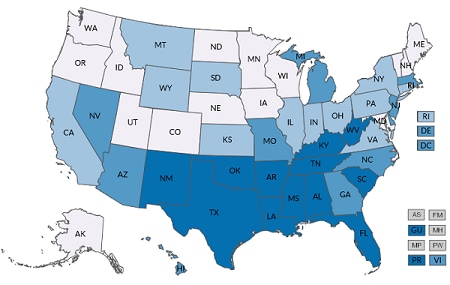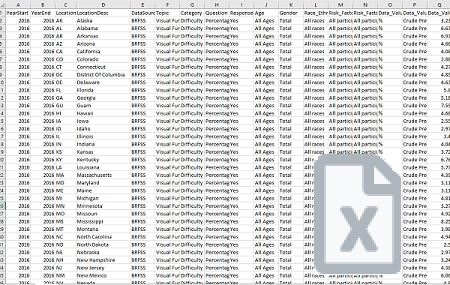American Community Survey
ACS at a Glance
| American Community Survey | |
|---|---|
| Description | National self-report survey |
| Sample | Sample of households that are nationally-, state-, and county-representative of the US population |
| VEHSS Topics Included | Vision Problems and Blindness |
| Approximate Size | 3 million people per year |
The American Community Survey (ACS), conducted by the United States Census Bureau, is an annual, nationally-representative household survey that collects and produces information on demographic, social, economic, and housing characteristics of the US population. ACS mails invitations to households to participate via internet. If no response is received, this is followed by invitations to participate via mail, telephone, or personal visit, in that order, based on participant response or non-response to each previous option. Data are collected from group quarters residents via personal interview only. The ACS serves the nation by providing a consistent and cohesive collection of characteristics that are comparable across all US geographies.
The Census Bureau releases summarized counts and prevalence rates from one or five years of ACS data through census.gov. The Census Bureau also releases the Public Use Microdata Sample (PUMS) files which can be used to create custom analyses that are not available through summary ACS data products such as the American Fact Finder.
The only vision-related question included in ACS is the Department of Health and Human Services standard disability question on vision: “Are you blind, or do you have serious difficulty seeing, even when wearing glasses?”.
VEHSS estimated the prevalence rate and sample size for the VEHSS categories listed below from single years of ACS PUMS data at the national and state level. The prevalence rate was defined as the number of people who gave an affirmative response to the question divided by the total number of respondents who gave an affirmative or negative response and multiplied by 100 for presentation in percentage format. Estimates with high uncertainty are suppressed (see VEHSS ACS Data Report). VEHSS reports county-level summary estimates from 5-year merged ACS, as reported directly by the Census Bureau without suppression.
ACS Questions Included in VEHSS
| VEHSS Topic – Category | VEHSS Indicator | ACS Variable Name | ACS Question Text | Sample |
|---|---|---|---|---|
| Vision Problems and Blindness – Vision Loss and Blindness | Percentage of people who are blind or have serious difficulty seeing even when wearing glasses | DIFFEYE | Is this person blind or does he/she have serious difficulty seeing even when wearing glasses? | All Ages |
Available Geographic Levels
| National | State | County |
|---|---|---|
| Included Stratification Factors (State and National Estimates) | |
|---|---|
| Age Group |
|
| Gender |
|
| Race/Ethnicity |
|
| Risk Factors |
|
| Data Type |
|
| Included Stratification Factors (County Estimates) | |
|---|---|
| Age Group |
|
| Gender |
|
| Race/Ethnicity |
|
| Risk Factors |
|
| Data Type |
|
A detailed description of the analytical steps is described in the report “VEHSS Survey Analysis Plan [PDF – 480 KB] .”
Full analysis documentation is included in the “VEHSS ACS Data Report [PDF – 359 KB] .”
ACS is a household response survey that contains only one question on visual function. In validation researched conducted by VEHSS, the self-report question included in ACS showed marginal diagnostic accuracy for predicting best corrected visual acuity loss and blindness in a sample of ophthalmology and optometry patients. However, this analysis did show that variation in the self-report question was highly correlated with variation in acuity among nearly all demographic groups. The prevalence of this measure cannot be directly translated into the prevalence of defined visual impairment or blindness.
ACS is not intended to be a health survey. ACS does not include health risk factors such as smoking, hypertension, or diabetes. In addition, ACS yields much lower estimates of vision loss than BRFSS or NHIS, even while using the same or similarly worded questions. It is possible that persons responding to a health survey may be primed to be more likely to answer in the affirmative to health questions.
ACS has a unique sampling frame; it is a household response survey with multiple modes of deployment. In addition, the accuracy and validity of self-reported difficulty seeing is unknown and is not directly analogous with objectively measured visual function, such as best corrected visual acuity. However, surveys do provide important information on variation and drivers of disparities in health outcomes that are not available in other data sources.
Finally, ACS PUMS is a subset of the full ACS. ACS PUMS includes geography at the state and PUMA level. In order to include county-level results, VEHSS reports county-level summary estimates released by the Census Bureau from merged 5-year ACS samples and does not include group quarters, such as nursing homes. Therefore, county-level results and state-level results in ACS are from different samples and do not reconcile.

